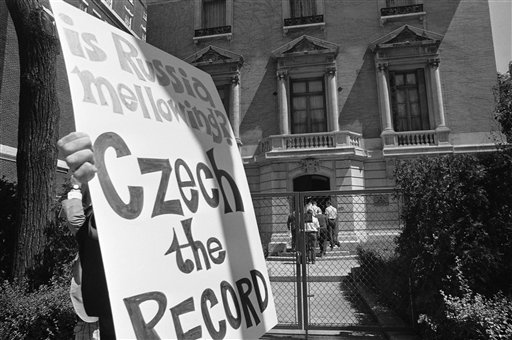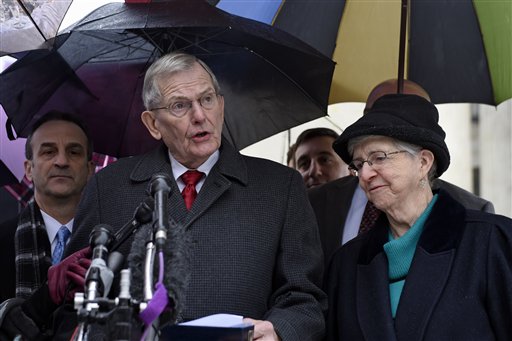

A content-based law or regulation discriminates against speech based on the substance of what it communicates. In contrast, a content-neutral law applies to expression without regard to its substance. The Supreme Court is likely to strike down regulations that discriminate on the basis of what is said or expressed. In reality, the Court’s case law establishes that content-based laws can be constitutional if they survive strict scrutiny. In one of the few cases that survived strict scrutiny, the Supreme Court in Burson v. Freeman, 504 U.S. 191 (1992), upheld a Tennessee law that provided for a 100-foot “campaign free zone” around the entrance to polling places. In this image, campaigners show signs outside the 100-foot "campaign free zone" in Knox County, Tennessee, elections in 2008. (Image via Brendan Loy on Flickr, CC BY-NC 2.0)
A content-based law or regulation discriminates against speech based on the substance of what it communicates.
In contrast, a content-neutral law applies to expression without regard to its substance. The Supreme Court is likely to strike down regulations that discriminate on the basis of what is said or expressed.
Designation of a law as either content based or content neutral is an important first step in ascertaining whether it violates the First Amendment.
Content-based laws are presumptively unconstitutional and subject to strict scrutiny, the highest form of judicial review, whereas content-neutral laws generally must survive only intermediate scrutiny.
Examples of laws that the Supreme Court has designated as impermissibly content based include:

Designation of a law as either content based or content neutral is an important first step in ascertaining whether it violates the First Amendment. Content-based laws are presumptively unconstitutional and subject to strict scrutiny, the highest form of judicial review, whereas content-neutral laws generally must survive only intermediate scrutiny. In Boos v. Barry (1988), a District of Columbia law prohibiting the display of signs critical of foreign governments within a certain distance outside embassies was designated as impermissibly content based. In this photo, one of many sign-carrying pickets before the Soviet Embassy in Washington D. C. marches down the sidewalk on 16th Street in 1969, protesting Soviet intervention in Czechoslovakia a year ago. (AP Photo/Henry Burroughs, used with permission from the Associated Press)
Viewpoint discrimination occurs when a governmental regulation restricts expression based not only on its content, but specifically on the underlying views in the message.
Content-based restrictions limit speech based on its subject matter, while viewpoint-based restrictions limit speech based on ideology and perspective. A law banning all political speeches in a public park would be content based; a law banning only political speeches by members of the Socialist Party would be viewpoint based. In the words of Justice Anthony M. Kennedy in Rosenberger v. Rector and Visitors of the University of Virginia (1995), “Viewpoint discrimination is thus an egregious form of content discrimination.”
Some language from Court opinions indicates that content-based laws are flatly unconstitutional.
In Police Department of Chicago v. Mosley (1972), Justice Thurgood Marshall wrote for the Court that “the First Amendment means that government has no power to restrict expression because of its message, its ideas, its subject matter, or its content.”

Good News Community Church Pastor Clyde Reed, center, accompanied by his wife Ann, talks to reporters outside the Supreme Court in Washington, Monday, Jan. 12, 2015. The Supreme Court sided with a small church in its fight with a Phoenix suburb over limits on roadside signs directing people to Sunday services. Liberal and conservative justices expressed misgivings Monday with the Gilbert, Arizona, sign ordinance because it was content-based, placing more restrictions on the churches’ temporary signs than those erected by political candidates, real estate agents and others. (AP Photo/Susan Walsh, used with permission from the Associated Press)
In reality, the Court’s case law establishes that content-based laws can be constitutional if they survive strict scrutiny.
For example, the Court in Burson v. Freeman (1992) upheld a law in Tennessee prohibiting the display of campaign materials within 100 feet of a polling place.
The Court also employs a categorization analysis providing that certain, narrow categories of expression — such as obscenity, child pornography, true threats, and incitement to imminent lawless action — can be prohibited precisely because of their harmful content.
The content-discrimination model remains a vital tool in First Amendment analysis. In the words of Justice Sandra Day O’Connor in City of Ladue v. Gilleo (1994), “no better alternative has yet come to light.”
In 2015, in Reed v. Town of Gilbert, the court reaffirmed the vitality of the content-based principle in invalidating an Arizona ordinance that treated directional signs differently than political or ideological signs. If the law “draws distinctions based on the message a speaker conveys,” it is to be treated as content-based and subjected to the highest level of scrutiny.
Justice Clarence Thomas wrote in the majority opinion: “A law that is content based on its face is subject to strict scrutiny regardless of the government’s benign motive, content-neutral justification, or lack of ‘animus toward the ideas contained’ in the regulated speech.”
David L. Hudson, Jr. is a law professor at Belmont who publishes widely on First Amendment topics. He is the author of a 12-lecture audio course on the First Amendment entitled Freedom of Speech: Understanding the First Amendment (Now You Know Media, 2018). He also is the author of many First Amendment books, including The First Amendment: Freedom of Speech (Thomson Reuters, 2012) and Freedom of Speech: Documents Decoded (ABC-CLIO, 2017). This article was originally published in 2009.